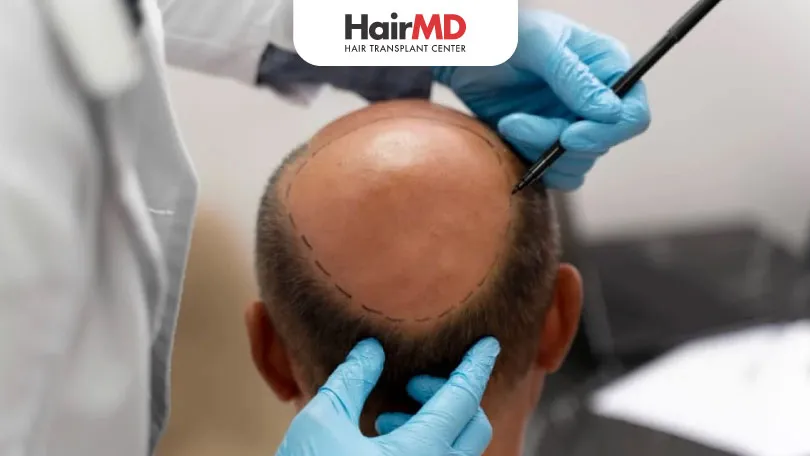14th Aug, 2022

Hair is often taken for granted until one starts to lose them and experiences balding. Hair loss and hair thinning are natural parts of the ageing process. But hair loss problems can be experienced by men and women at an early age due to medical stress, medical conditions, genetics, etc.
The hair loss condition is medically termed alopecia, a disorder caused by an interruption in the body’s hair production cycle. Read this article to know more about hair loss and treatment.
What’s covered in the article?
- What is Hair Transplant?
- Types of Alopecia and Hair Loss Conditions
- Eligibility Criteria for Hair Transplant
- How is a Hair Transplant Procedure Carried Out?
- What is the Hair Transplant Cost in India?
- Recovery and Care Post Hair Transplant
- Conclusion
What is Hair Transplant?
Hair boosts confidence, and when thinning and baldness begin to occur, it’s time to seek medical help to get the right medication and surgical treatments that can stop the balding process by giving you new and fuller hair. First, people experiencing hair loss try topical and herbal solutions to restore their hair. These procedures may not work for everyone, and if they work, these are time-taking procedures. Many people misunderstand hair transplant surgery with artificial implants, where synthetic fibres are sewn to the scalp. These may not give a natural look and do not grow over time.
The hair transplant procedure is a surgical process which involves transferring hair from an unaffected area by hair loss, also known as the donor area, to the balding area or thinning area. For this procedure, the donor area should have thicker hair which can be the back of the scalp or any other part of the body, and then this hair is grafted to the thinning or balding area of the scalp to give a natural look. The transplanted hair acts the same way as the naturally grown hair follicles since these are living follicles. The transplanted hair grows naturally like the hair in the donor area of the scalp. It is one of the most desirable procedures for androgenic alopecia.
The three most popular and latest hair transplant techniques are FUT, FUE and DHT.
Follicular Unit Transplantation
Follicular Unit Hair transplant is, also known as FUT, a strip hair transplant surgery with a minimally invasive process. In FUT, the doctor removes strips of tissue from the permanent hair zone of the scalp or the donor area. Once the tissue has been extracted, the strips of the tissue are further cut into several grafts. Then each graft with a hair or a few hairs is grafted individually as follicular units by making small cuts on the scalp. This procedure helps to cover bald spots caused by hair loss. The FUT leaves a linear scar at the donor site.
FUE (Follicular Unit Extraction)
Follicular Unit Extraction or FUE is a modern technique adopted by hair transplant surgeons and patients as it leaves fewer or no scars post-procedure than FUT. For this procedure, the individual hair follicles are directly extracted from the donor area, especially the scalp’s back, as this area is generally not affected by DHT hormones. When attached to the hair follicles, DHT hormones weaken the hair, leading to hair loss. The extracted follicles are then transplanted to the affected site using microsurgical needles. The surgeons use these specialised needles to make tiny holes in the scalp in which the extracted hair is gently transplanted. Through this method, thousands of hair can be transplanted during one session. The scarring in this procedure is not noticeable and the patient does not require any stitches.
Advance FUE method
The advanced FUE method is also known as DHT or direct hair transplant, and it is a more modified version of FUE hair transplant. Unlike the older version of FUE, in this procedure, no motorised punching or holes are created to transplant the follicular units to the balding area. The follicular units from the donor area are extracted manually and transplanted to the affected area with the help of a transplanter. The graft extractions before implantation are kept in a liquid solution that maximises the survivability rate of the live follicles.
This procedure can help transplant hair from regions like the beard, chest, or pubic area without giving an unnatural look. This procedure can help recover lost hairline and even add density to the hair.
As this procedure is less scarring, it is desirable for both surgeons and patients. The eligibility for this process depends on the hair loss condition of the patient, and the hair transplant surgeon may use a combination of procedures as well.
Types of Alopecia and Hair Loss Conditions
Androgenetic Alopecia
It is the most common type of hair loss problem and is also known as male or female pattern hair loss. It can be hereditary but can be managed with medications and procedures like PRP, mesotherapy and dermaroller and a hair transplant procedure.
Telogen Effluvium
Telogen effluvium occurs when hair follicles on the scalp enter the resting phase of the hair growth cycle, called telogen, and the next growth phase does not start. It can occur due to medications, stress and other factors like infections. It is temporary.
Anagen Effluvium
Anagen effluvium is rapid hair loss resulting from medical treatment, such as chemotherapy, and it is reversible as new hair starts growing after the chemotherapy is stopped.
Alopecia Areata
Alopecia areata is an autoimmune condition, which means the body’s immune system attacks healthy tissues and stops new hair growth. Hair Transplant surgery is not considered a good option for patients with Alopecia areata. A hair transplant is only possible after the stabilisation of the disease.
Hair transplants are regarded as one of the most effective reconstructive surgeries for a natural look. Let’s understand what a hair transplant is and how it is done.
Eligibility Criteria for Hair Transplant
It is one of the most common questions that comes in the mind of patients who want to reverse their hair loss problems. Ask your surgeon before finalising treatment.
There is no lower or upper age limit for candidates to choose hair transplant as the reason for hair loss can be many and can occur at any age for both men and women. The causes of hair loss can be:
- Hormonal Disorders
- Stress
- Nutritional Deficiencies
- Bacterial Infections
- Cancer
- Ageing
- Family History
- Birth Defect
- Accident
The criteria that matter are the patient’s overall health condition and whether the patient is suitable for a hair transplant procedure. Hair loss impacts the social and professional life of the person. A hair transplant is a proven treatment to get the full growth of hair back. What do surgeons look for before recommending the treatment:
- The donor area on the scalp should have enough healthy hair to be extracted and transplanted to the balding area.
- The scalp should be healthy enough to grow the transplanted hair in a natural course of time, like the hair in the donor area.
- The donor area should have 7000- 8000 grafts to successfully transplant hair to the larger affected area of the head.
- A completely bald person may opt for a hair transplant from other body parts like the armpit, chest or beard.
The dermatologist will do a thorough scalp, hair and donor area analysis to determine the cause of hair loss and suggest the right treatment. The patients may also need a blood test. These tests help determine whether you meet the criteria mentioned above. The hair transplant surgeon can tell you which procedure suits your condition the best after the examination.
How is a Hair Transplant Procedure Carried Out?
Hair transplant surgery is generally an outpatient procedure, and the entire procedure may take 4-8 hours. The hours also depend on the number of grafts to transplant to the scalp’s affected area. First, the patient’s scalp is cleansed, and local anaesthesia is injected to numb the area. Patients remain awake during the entire operative procedure, yet some patients may be given some mild sedatives to relax.
The surgical procedure depends on the type of hair transplant technique being done.
If the FUT method has been chosen, the surgeon will start the surgery by extracting healthy hair tissues from the donor area, generally the back of the scalp. About 6 to 10-inch strips of skin are removed and kept aside in a solution to be used for transplant. The donor area is then sewn and bandaged. The removed tissue is further cut into 500 to 2,000 tiny grafts, each with an individual hair or just a few hairs. The number of grafts depends upon hair quality, texture and balding or thinning area requirements. This procedure is faster compared to the FUE process.
In the FUE procedure, the surgeon will shave the back of your scalp, and then individual hair follicles will be extracted from that area and transplanted to the affected area.
In both cases, the incisions are made; in FUT, it will be like an elongated cut leaving the area scarred and slowly fading away with new hair growth. In FUE, small holes are made into the scalp to implant individual follicles, and this procedure leaves the scalp less scarred.
Whichever procedure is chosen, once the transplantation process is over, the patient’s scalp is bandaged and care at-home instructions are provided to the patient. The visible results can be seen within 6-9 months post-surgery; in some cases, it may take up to 12 months. It is also important to note that the transplanted hair may fall out within 2-8 weeks post-surgery. It is normal as it is the shedding phase before the anagen phase gets activated, and new hair growth is experienced within 6-9 months.
What is the Hair Transplant Cost in India?
The cost of India’s best hair transplant surgery depends on various factors. First, choose a board-certified hair transplant surgeon and a reputed clinic that adheres to global operating techniques and patient care standards. Word of mouth and personal recommendations can also help you choose the right surgeon and hair transplant clinic.
The cost of reputed hair transplant clinics and board-certified surgeons may be higher, but it also ensures a better success rate and patient satisfaction.
The technique of the procedure and the number of grafts required also affect the hair transplant cost in India. If you are looking for a board-certified and reputed hair clinic in Pune, you may visit HairMD, a leading and certified clinic for all hair transplants in Pune.
Recovery and Care Post Hair Transplant
Hair transplant surgery is one of the most effective surgeries for long-term full hair growth, which is natural. Like any surgery, hair transplants may also have some risks, including bleeding and infection, and some may experience an infection of hair follicles called folliculitis. Antibiotics and other medications prescribed by the doctor will give relief from the problem.
A hair transplant is an outpatient surgery, and the patient can go home the same day. Initially, the patients may feel excessive tightness, bruises and discomfort; these fade away with prescribed medication. Avoid sudden jerks and movement of the scalp till the operated area has healed properly. Doctors even recommend washing your hair two days after the procedure. The noticeable hair growth can be seen 6-9 months from the procedure, and the hair begins regrowing at an average rate of 1cm per month. After the stipulated recovery time, you can continue with your normal hair care routines.
Here are some aftercare tips for hair transplant surgery:
- Wait a few days after the surgery to wash your hair. Only use mild shampoos for the first few weeks.
- You should be able to return to work or normal activities in about 3 days.
- Don’t press a brush or comb down over the new grafts for about 3 weeks.
- Don’t wear any hats or pullover shirts and jackets until your doctor says it’s OK.
- Don’t exercise for about a week.
Don’t worry if some hair falls out. This is part of the process. The transplanted hair may not grow much or seamlessly match the hair around it for a few months.
Do You Know?
Nearly 250 Patients Visit HairMD
Everyday For Various Hair Concerns?
(Your journey to healthier and fuller hair starts here!)
Meet Our Dermatologists
Conclusion
Hair transplant procedures are now more effective, with a good success rate. Hair transplants in Pune can be done at HairMD here, the hair transplant surgeons hold expertise in these procedures. They understand the needs of the patients and their condition and recommend the right procedure accordingly.
Further Reading
Oily Scalp After Hair Transplant and How to Manage It
Oily scalp after hair transplant is common and manageable. Get simple care tips to reduce oiliness and support a smooth recovery.
Hair Transplant Myths & Facts
Uncover the truth behind common myths about hair transplants. Learn the facts about the procedure, recovery, results, and who makes an ideal candidate for a successful transplant.
How to remove scabs after Hair Transplant? | HairMD
The correct way to remove scabs after hair transplant without damaging grafts. Get expert-backed tips from HairMD Pune to support a smooth recovery.
Shedding Phase After Hair Transplant
Discover essential medications post-hair transplant like finasteride and minoxidil. Learn tips for care and recovery from HairMD Pune experts.
Have thoughts? Please let us know
We are committed not only to treating you, but also educating you.










